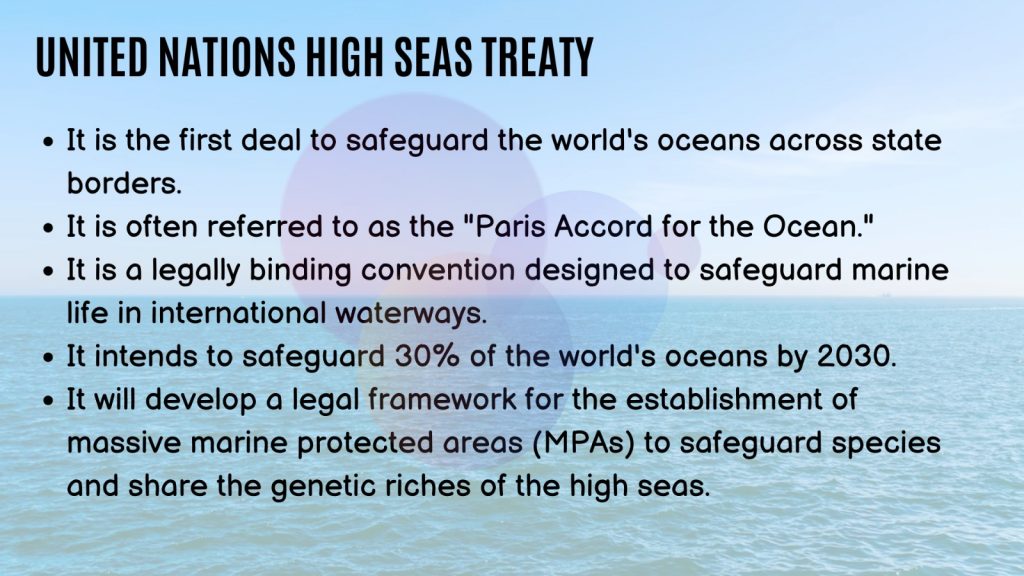News Highlight
India supports marine protected areas in Antarctica to conserve ocean life.
Key Takeaway
- India will continue to assist in establishing two Marine Protected Areas (MPA) in Antarctica to conserve marine life and ecosystem services.
- A marine protected area (MPA) is a specified area managed for the long-term conservation of marine resources, ecosystem services, or cultural heritage.
- The Southern Ocean, which encircles Antarctica, accounts for around 10% of the global ocean and is home to nearly 10,000 unique polar species.
Marine Protected Areas (MPAs)
- About
- MPAs are ocean areas designated for long-term protection.
- They aid in adapting and mitigating climate change while delivering other ecosystem services.
- Individual marine protected areas (MPAs) might have different aims, legal authority, levels of protection, management systems, and use allowances.
- Several MPAs allow individuals to use the area in environmentally friendly ways.
- Several places prohibit fishing.
- Some do not permit anyone to enter the region at all.
- MPAs now cover around 6.35% of the ocean.
- Yet, slightly more than 1.89% of that land is protected by no-take MPAs.
- It prohibits fishing, mining, drilling, and other extractive activities.
Importance of MPAs
- Biodiversity Conservation
- MPAs provide critical habitats for threatened and endangered species such as fish, marine mammals, birds, and other aquatic animals.
- Ecosystem protection
- MPAs protect vital maritime ecosystems such as coral reefs, mangroves, and seagrass beds.
- Sustainable resource use
- MPAs can help ensure maritime resources are utilised sustainably for future generations.
- It will be accessed if marine ecosystems and species are preserved.
- Climate change mitigation
- MPAs can help mitigate climate change’s consequences by safeguarding marine habitats and the species that rely on them.
- These habitats and animals are critical for managing the Earth’s temperature and weather patterns.
- Economic benefits
- MPAs can provide commercial benefits such as increased fish stocks and improved water quality.
- As well as economic benefits such as increased tourist and recreational opportunities.
Challenges of MPAs
- Lack of enforcement
- Rules within MPAs can be difficult to apply, especially in remote areas with few patrols.
- Porous boundary
- It is difficult to halt illegal fishing, poaching, and other behaviours threatening ecosystems and marine life.
- Conflicts with local communities
- MPAs may occasionally impede the capacity of local fishing groups and other coastal users to retain their way of life.
- Limited financial and institutional support
- MPAs require significant money to be efficiently administered, including funds for enforcement, monitoring, and research.
- Limited scientific understanding
- From a scientific standpoint, the intricate marine ecosystems and their creatures are little known.
- This makes it difficult to successfully manage MPAs and build conservation policies based on strong scientific knowledge.
Marine Protected Areas in India
- The MPAs in India comprise 33 national parks and wildlife sanctuaries recognised under the Wildlife (Protection) Act of 1972.
- The Gulf of Kutch Marine National Park and Marine Sanctuary are one entity, and Bhitarkanika National Park and Bhitarkanika Sanctuary are vital parts of one MPA.
- Hence, India has a total of 31 MPAs.
- MPAs account for less than 4.01% of India’s protected area.
Way Ahead
- MPAs are critical for preserving India’s coastal populations and unique marine heritage.
- MPAs, on the other hand, must function successfully to be successful.
- Despite various challenges, marine protected areas (MPAs) are increasingly vital for safeguarding and effectively managing India’s marine resources.

Conclusion
- India’s maritime protected areas are home to diverse species, attracting visitors worldwide.
- Since the Wildlife Protection Act was passed in 1972, the Wildlife Conservation Society has fought tirelessly to safeguard marine biodiversity.
- Vast areas of land remain susceptible.
- Animals that make our country proud and are part of our rich heritage must be safeguarded, and we Indians must decide to do so.
- Greater collaboration between governmental organisations, academic institutions, and local communities is essential to address these difficulties.
Pic Courtesy: IAN
Content Source: Down to Earth



